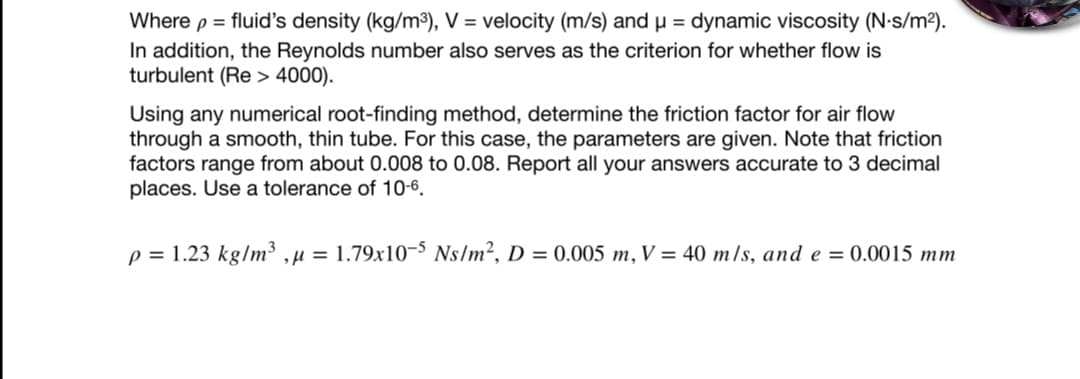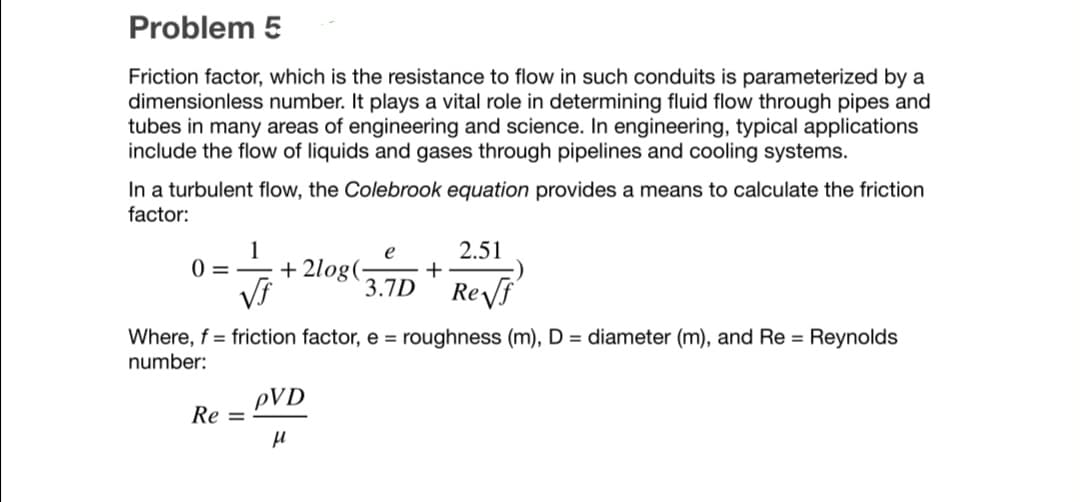Friction factor, which is the resistance to flow in such conduits is parameterized by a dimensionless number. It plays a vital role in determining fluid flow through pipes and tubes in many areas of engineering and science. In engineering, typical applications include the flow of liquids and gases through pipelines and cooling systems. In a turbulent flow, the Colebrook equation provides a means to calculate the friction factor: 1 0 = =+ 2log(- 2.51 + 3.7D ' Reyf Where, f = friction factor, e = roughness (m), D = diameter (m), and Re = Reynolds number: pVD Re =
Friction factor, which is the resistance to flow in such conduits is parameterized by a dimensionless number. It plays a vital role in determining fluid flow through pipes and tubes in many areas of engineering and science. In engineering, typical applications include the flow of liquids and gases through pipelines and cooling systems. In a turbulent flow, the Colebrook equation provides a means to calculate the friction factor: 1 0 = =+ 2log(- 2.51 + 3.7D ' Reyf Where, f = friction factor, e = roughness (m), D = diameter (m), and Re = Reynolds number: pVD Re =
Power System Analysis and Design (MindTap Course List)
6th Edition
ISBN:9781305632134
Author:J. Duncan Glover, Thomas Overbye, Mulukutla S. Sarma
Publisher:J. Duncan Glover, Thomas Overbye, Mulukutla S. Sarma
Chapter6: Power Flows
Section: Chapter Questions
Problem 6.27P
Related questions
Question
Includes codes using octave gnu

Transcribed Image Text:Where p = fluid's density (kg/m³), V = velocity (m/s) and µ = dynamic viscosity (N-s/m²).
In addition, the Reynolds number also serves as the criterion for whether flow is
turbulent (Re > 4000).
Using any numerical root-finding method, determine the friction factor for air flow
through a smooth, thin tube. For this case, the parameters are given. Note that friction
factors range from about 0.008 to 0.08. Report all your answers accurate to 3 decimal
places. Use a tolerance of 10-6.
p = 1.23 kg/m³ ,µ = 1.79x10-5 Ns/m², D = 0.005 m, V = 40 m/s, and e = 0.0015 mm

Transcribed Image Text:Problem 5
Friction factor, which is the resistance to flow in such conduits is parameterized by a
dimensionless number. It plays a vital role in determining fluid flow through pipes and
tubes in many areas of engineering and science. In engineering, typical applications
include the flow of liquids and gases through pipelines and cooling systems.
In a turbulent flow, the Colebrook equation provides a means to calculate the friction
factor:
2.51
1
+ 2log(-
3.7D ' Reyf
e
0 = -
Where, f = friction factor, e = roughness (m), D = diameter (m), and Re = Reynolds
number:
pVD
Re =
Expert Solution
This question has been solved!
Explore an expertly crafted, step-by-step solution for a thorough understanding of key concepts.
This is a popular solution!
Trending now
This is a popular solution!
Step by step
Solved in 3 steps with 1 images

Knowledge Booster
Learn more about
Need a deep-dive on the concept behind this application? Look no further. Learn more about this topic, electrical-engineering and related others by exploring similar questions and additional content below.Recommended textbooks for you

Power System Analysis and Design (MindTap Course …
Electrical Engineering
ISBN:
9781305632134
Author:
J. Duncan Glover, Thomas Overbye, Mulukutla S. Sarma
Publisher:
Cengage Learning

Power System Analysis and Design (MindTap Course …
Electrical Engineering
ISBN:
9781305632134
Author:
J. Duncan Glover, Thomas Overbye, Mulukutla S. Sarma
Publisher:
Cengage Learning